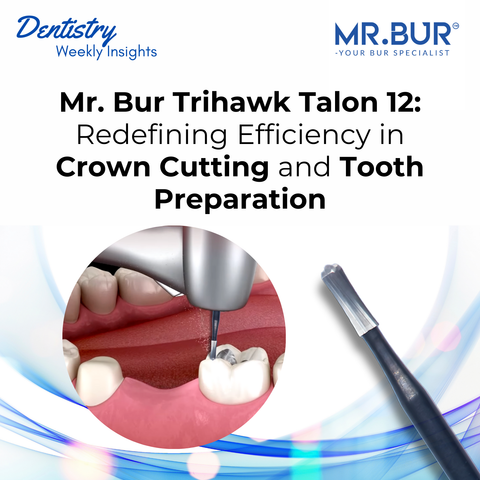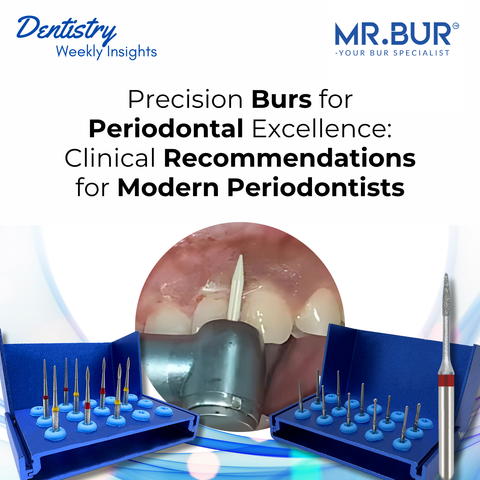Dental implantology demands surgical precision, bone preservation, and controlled site preparation. While implant systems and guided techniques receive considerable attention, one crucial component often overlooked is the selection of specialized dental burs. These rotary instruments play a pivotal role in osteotomy preparation, site refinement, and soft tissue management, directly impacting the stability, success rate, and longevity of the implant.
This article explores the types of burs optimized for implantology and their applications across various surgical stages, including insights into how dedicated tools like the Mr. Bur Implantology Series can support predictable clinical outcomes.
The Role of Burs in Dental Implant Procedures
Dental burs used in implant surgery are engineered for:
-
Cutting dense cortical and cancellous bone
-
Removing granulation or infected tissue
-
Adjusting soft tissue contours
-
Refining osteotomy sites prior to implant insertion
Proper bur selection contributes to:
-
Maintaining bone vitality
-
Achieving primary implant stability
-
Facilitating osseointegration
-
Minimizing surgical complications such as overheating or poor angulation
Key Categories of Burs in Implantology
1. Osteotomy Preparation Burs
Successful implant placement depends on achieving a precise, biologically sound osteotomy. While most implant systems include proprietary drills, Mr. Bur offers essential adjunctive burs that enhance bone modification, improve access in challenging anatomy, and support precise osteotomy correction, particularly in compromised or narrow ridges.
Mr. Bur Lindemann Bur
Type: Tungsten carbide, side-cutting surgical bur
Design Features:
-
Lateral cutting blades along the body allow for effective sideward bone removal, ideal for widening osteotomy sites or correcting paths.
-
Long shank design supports deep access during posterior surgeries or when working near anatomical structures like the mandibular canal.
-
Pointed tip facilitates controlled initial entry or penetration of cortical bone without skidding.
Clinical Applications:
-
Ridge Expansion: Used to widen narrow alveolar ridges to create space for implant insertion without over-relying on chisels or osteotomes.
-
Osteotomy Path Correction: Allows clinicians to adjust implant trajectory intraoperatively if the initial path is off-angle, especially helpful in posterior molar sites.
-
Access Channel Creation: Effective in dense cortical areas where standard twist drills may deflect or overheat.
-
Lateral Bone Windowing: Can be used for lateral sinus lift access or creating a channel in corticotomy procedures.
Recommended Parameters:
-
Speed: 800–1500 RPM
-
Coolant: Continuous external sterile saline irrigation is essential to avoid heat-induced osteonecrosis.
-
Pressure: Light, intermittent pressure to allow irrigation to flow and reduce frictional heat buildup.
2. Degranulation and Debridement Burs
These burs are critical in preparing infected or previously failed implant sites.
Product Highlight:
-
Includes round-ended burs: RAXL10 (1.0 mm), RAXL25 (2.5 mm), RAXL30 (3.0 mm), and RAXL35 (3.5 mm)
-
Designed for safe and thorough degranulation of extraction sockets or infected bone areas
-
Ideal for use with saline irrigation at 300–1200 RPM depending on bone density
Clinical Indications:
-
Granuloma or cyst removal
-
Peri-implantitis debridement
-
Root tip removal in apicoectomies
-
Cleaning sinus lift windows during lateral approach
Benefits:
-
Minimal damage to vital bone
-
Soft tissue selectivity
-
Reduced bleeding due to efficient coagulation effect
3. Soft Tissue Management Burs
Pre- or post-implant placement, some cases may require soft tissue contouring for emergence profile or flap closure.
Product Highlight:
-
Non-metal, blood-coagulating ceramic body
-
Enables precise epithelial removal and contouring
-
Used with water spray to avoid heat damage
Indications:
-
Gingival margin shaping post-second-stage surgery
-
Frenectomy contouring
-
Removal of excess granulation tissue during implant uncovering
Why Use Implant-Specific Burs?
|
Clinical Requirement |
Standard Bur Limitation |
Implant-Specific Bur Advantage |
|
Lateral osteotomy correction |
Cannot side-cut or change angulation |
Lindemann bur allows precise redirection |
|
Debridement of infected sites |
Soft tissue trauma, inefficient removal |
Degranulation burs preserve healthy bone |
|
Soft tissue sculpting |
Risk of bleeding or thermal damage |
Ceramic burs trim with control and coagulate |
Precision Starts with the Right Bur
While implant success often centers around prosthetic design or osseointegration, the surgical foundation starts with the burs you select. Specialized burs are engineered to adapt to surgical variables like bone density, anatomical challenges, and soft tissue conditions.
Mr. Bur offers a full range of implant-specific burs, including:
-
Lindemann burs for controlled bone shaping
-
Degranulation kits for peri-implant and revision procedures
-
Ceramic burs for soft tissue management
Investing in the right burs enhances surgical efficiency, minimizes complications, and supports long-term implant success.
Diamond Burs, Carbide Burs, Surgical & Lab Use Burs, Endodontic burs, IPR Kit, Crown Cutting Kit, Gingivectomy Kit, Root Planning Kit, Orthodontic Kit, Composite Polishers, High Speed Burs, Low Speed Burs


